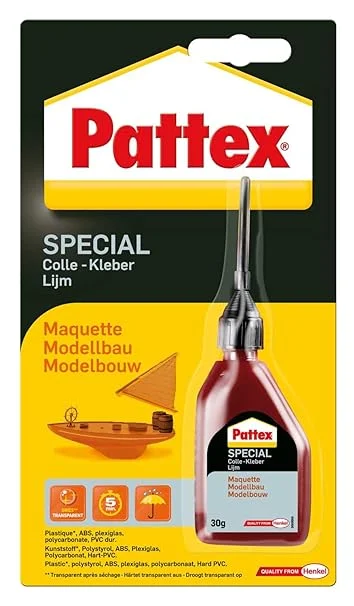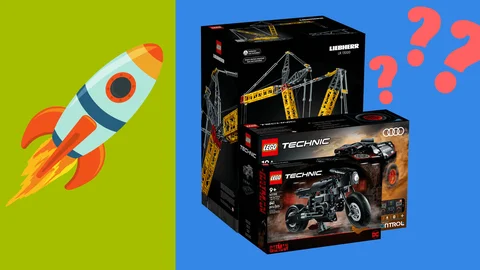Gluing Lego® bricks is a controversial topic among brick enthusiasts and is rejected in most cases. It contradicts the basic idea of creative building and the possibility of redesigning the structures at a later date. Lego itself also advises against gluing the colorful bricks together.
However, there are some special circumstances in which the gluing of Lego bricks can be considered. In this guide, we will introduce you to the three best glues for Lego and show you what you should consider when choosing a glue. We will also look at situations in which gluing Lego bricks could be interesting. Before you start gluing, you should clean your Lego bricks so that the glue holds well.
Glue for Lego®: Our favorites
Are you looking for a suitable adhesive to glue Lego® parts together? In the following overview, we present our three best adhesives for Lego, which are particularly suitable for gluing Lego. In general, you should always make sure that the adhesive is designed for ABS plastics.
1. Uhu Allplast adhesive

- Drying time: Fast
- Special: Fast and precise work required
- View here on Amazon
An inexpensive yet good adhesive for Lego® parts is Uhu Allplast glue, which dries quickly and fuses plastic parts effectively, making it ideal for precision applications. Its ability to bond quickly and strongly makes it perfect for permanently joining Lego parts, but requires quick and skillful work.
2. Pattex PXSM1 model making adhesive

- Drying time: Fast
- Special: With micro-dosing needle for precise work
- View here on Amazon
In addition to the classic ABS adhesive, a special modeling adhesive can also be used. The Pattex special modeling adhesive developed for plastics offers an optimum bond for Lego® parts thanks to its high adhesive strength and residue-free drying. A micro-dispensing needle enables precise application, ideal for finer constructions. Although this adhesive is slightly more expensive than conventional ABS adhesives, its performance and durability justify the investment.
3. CBL adhesive
- Drying time: Fast
- Special: Only for special cases
An alternative to ABS glue is CBL, which is strictly regulated in Germany and should only be used in special cases. CBL (butyro-1,4-lactone) bonds the Lego® parts on a molecular level to form an extremely strong connection.
This process ensures an extremely strong and durable bond between the bricks, similar to the technique Lego itself uses for some of its own processes. Despite its effectiveness, it is not suitable for everyday use due to safety concerns and strict regulation in Germany and should only be used under special conditions.
When should I glue Lego®?
As already mentioned, the gluing of Lego® parts is a frequently discussed topic among brick enthusiasts. As a rule, the already high clamping force of Lego is sufficient and gluing is not necessary. However, there are situations in which gluing Lego bricks may be necessary.
Lego® MOC
Gluing Lego® bricks is particularly interesting for farmers of Lego MOCs.
They often exhibit their Lego models at exhibitions or trade fairs. Gluing the Lego bricks or parts is an advantage for frequent transportation. Furthermore, some models are so large that they would not hold together without the best Lego glue.
Exhibits
Similar to Lego® MOCs, gluing Lego sets that are permanently displayed in a showcase, for example, can also be interesting. This way, nothing can fall apart during frequent moving or rearranging.
Security
In environments where it is important that small parts do not come loose and cannot be swallowed by small children, gluing can be a safety measure. However, Lego® Duplo sets are generally recommended for small children, as their bricks cannot be swallowed by small children due to their size.
You can find suitable sets for toddlers in our Lego Duplo VS. Mega Bloks comparison.
Lego® glue: Checklist
When choosing an adhesive for Lego® bricks, there are a few points that should be taken into account. The adhesives we have previously presented fulfill all the points on this list. However, there are other products that are suitable for gluing Lego bricks. In the following checklist, we explain what you should consider when making your choice.
Material compatibility
- The Lego® glue must be compatible with ABS plastic (material of the Lego bricks).
- Check whether the adhesive attacks or damages plastics.
Adhesion and strength
- Choose an adhesive with high adhesive strength for a strong and durable bond.
- Consider the stress on the bonded parts and select an adhesive with the appropriate strength.
Drying time
- Note the drying time of the adhesive. Quick-drying adhesives are practical, but leave less time for subsequent corrections.
Adhesive residues
- Check whether the glue dries transparently or whether visible traces remain that could affect the appearance of your Lego® models.
Health and safety
- Observe the toxicity and safety instructions of the adhesive. Use in a well-ventilated area and wear suitable protective clothing (gloves).
Cost
- Compare the cost of different adhesives, taking into account their performance and the quantity required.
- Pay attention to the price-performance ratio, especially if you need large quantities.
Step-by-step instructions: Glueing Lego®
In the following step-by-step instructions, we will show you how to glue Lego® bricks together. This could be interesting, for example, if you want to display a self-built Lego model with cool Lego minifigures without it breaking apart during transportation.
Step 1: Clean the surfaces
Make sure that both Lego® parts to be glued are clean and free of dust to ensure optimum adhesion.
Step 2: Select adhesive
Use a suitable adhesive recommended for ASB plastics that dries transparently so as not to impair the aesthetics of the buildings.
Step 3: Test the adhesive
First test the adhesive on an inconspicuous part or a replacement piece to check how it dries and whether it leaves any residue.
Step 4: Apply the adhesive
Apply the adhesive sparingly to one of the Lego® parts to be connected. Some adhesives require application on both sides.
Tip: A bristle brush, for example, can be used for application.
Step 5: Joining the Lego® pieces together
Press the Lego® bricks firmly together for the manufacturer's recommended time to ensure good initial adhesion. Detailed information about the recommended time can be found either on the packaging of the glue or in its instructions.
Step 6: Allow to dry
Wait for the full curing time indicated on the adhesive packaging before you continue to use or load your Lego® model.
Step 7: Remove adhesive residue
If any adhesive residue is visible, carefully remove it with a suitable solvent without damaging the Lego® parts.
The best adhesives for Lego®: Conclusion
To summarize, although gluing Lego® bricks is not recommended, as it goes against the original idea of creativity and changeability, it can make sense in certain circumstances. Gluing can be a practical solution, especially if the models are exposed to increased loads, e.g. during exhibitions or transportation, or if increased safety is required.
It is important to select a suitable adhesive that is specially adapted to the ABS plastic of the Lego bricks in order to ensure a durable and secure bond.
The adhesives presented - Uhu Allplast Glue, Pattex PXSM1 Model Making Glue and GBL Glue - offer different properties that need to be evaluated depending on the intended use. Safety aspects, especially when dealing with children, as well as careful preparation and application of the adhesive are crucial in order to achieve the best possible result and maintain the integrity of the models.
FAQ: Gluing Lego® bricks
When dealing with Lego® and the idea of gluing individual bricks together permanently, questions often arise. This FAQ answers the most important questions about gluing Lego.
Is it recommended to glue Lego® bricks?
No, gluing Lego® bricks is generally not recommended as it contradicts the basic idea of creative building. It is important that Lego bricks can be reshaped.
When can the gluing of Lego® bricks be considered?
Gluing can be considered, especially for display pieces or Lego® models that are frequently transported, to protect them from falling apart.
Which glue is suitable for Lego® bricks?
Use a glue that is especially suitable for ABS plastics, such as Uhu Allplast glue or Pattex PXSM1 model making glue.
Can I use any glue for Lego® bricks?
No, you should always choose an adhesive that is compatible with ABS plastic to avoid damage.
What should I consider when choosing the glue?
Pay attention to material compatibility, adhesion and strength, drying time, whether the glue dries transparently, as well as safety and health instructions.
How do I prepare the Lego® bricks before gluing?
Make sure that the Lego® pieces are clean and free of dust to ensure optimum adhesion.
How do I apply the glue?
Apply the glue sparingly to one of the surfaces to be joined, and with some adhesives possibly to both sides.
How do I remove adhesive residue from Lego® bricks?
If adhesive residue is visible on the Lego® bricks, it should be carefully removed with a suitable solvent so as not to damage the Lego® parts.
Want to buy Lego sets cheap? In the Brickfact price comparison you can choose from a list of suppliers and buy Lego sets at the best price. The Brickfact app informs you via push notification as soon as a new Lego deal is available. The Brickfact app is free and available for both iOS and Android.






